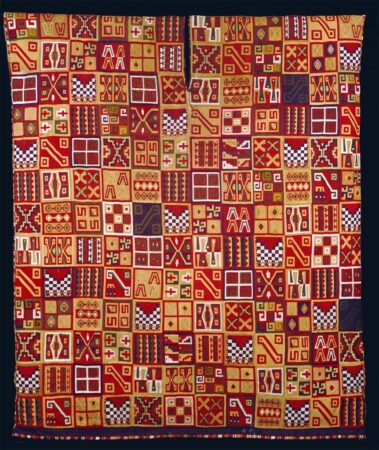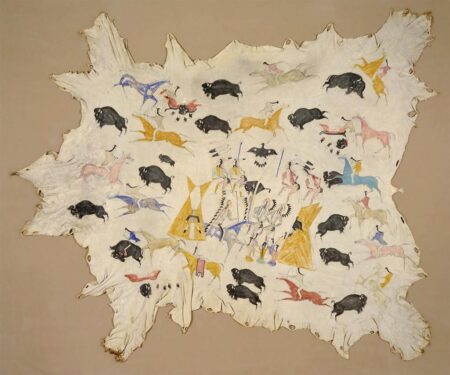A well-deserved salute to AP® Art History teachers
- Tlatilco, Female figure, 1200-900 B.C. Image and data from: Princeton University Art Museum, Image © Princeton University Art Museum, photo: Bruce M. White.
- Jean Antoine Houdon, George Washington Statue; overview, 1785-1788, Richmond, VA. Image and original data provided by Art on File; artonfile.com.
- Made for Prince al-Mughira, Pyxis of al-Mughira; the prince seated with his lutist and fan-bearer, 968. Image and original data provided by Walter B. Denny.
Each May, around the world, almost twenty five thousand students sit for the AP® Art History exam. This year’s test falls on the third of May (a date not lost on many seasoned Art History teachers). It is also quite different from the AP® exam you or your children may have taken. This time, students will be taking a test that covers a newly designed AP® Art History curriculum. This is the first year that the exam is truly global in nature.
This curriculum includes works from the European tradition that we all learned in our survey course, such as the Acropolis, but also goes beyond that to include artists from Native American tribal traditions, the rest of the Americas, and works from the Pacific, Africa, and Asia. There are now 250 key works of art or architecture that a student must know quite well in addition to those the teachers and students explore to round out the experience. For the first time, the AP® Art History exam covers something of the cultural heritage of each student in the room while providing them the chance to learn about our global artistic production.
- Unknown, Tunic, Dumbarton Oaks Pre Columbian Collection. Kerr Archive.
- Cadzi Cody, Scenes of Plains Indian life, about 1900. Image and data from The Minneapolis Institute of Arts.
- House of the Vettii, triclinium n, wall scheme with fictive architecture and death of Pentheus, c. 62-79 CE. Image and original data provided by Canyonlights World Art Slides and Image Bank.
For a teacher, the day of the AP® Art History exam is an experience like no other. After an academic year of leading students in discussions of art historical concepts, the exploration of various media and techniques, and contextualizing works of art within cultural traditions, while also drawing connections across cultures, a teacher must relinquish access to those wonderfully chock-full minds. At high noon on the appointed date, students are sent to a room to sit for a three-hour exam not created by that teacher. The exam, which is written by a committee of exemplary AP® art history teachers and higher education faculty, includes essays based on images, multiple-choice questions and even one unknown work of art that students must attribute to an artist or movement. The instructor cannot go in the room, cannot chat with the students during the one break in the exam, and cannot even discuss the exam with students for 48 hours. Students and teachers can never discuss the majority of multiple-choice questions on the exam.
As a teacher, I remember fondly that first discussion 48 hours after the exam when we all worked to make everyone feel good about their answers as we reviewed the content we were allowed to discuss. Students would laugh at themselves for silly mistakes, rejoice when they thought they did well, and, inevitably, the conversation would become one about art history again, where the learning would continue with a group of thinkers who have come to love the history of art.
I have not been in the classroom now for a couple of years. I have been making resources for this new curriculum for Artstor subscribers located in our Teaching Resources section. It has been an amazing experience of research, collaboration with scholars and other teachers, and writing, lots of writing. There were days when mosques, stupas, and temples overwhelmed me, and days of great clarity when I saw the brilliance of particular additions to the curriculum. Through this work, I have come to feel I am a kindred spirit to my former colleagues teaching the course. I have enjoyed camaraderie with several teachers at Artstor subscribing schools as they use those resources, make valuable suggestions, and ask probing questions that make my work better.
This year teachers did especially hard work learning side by side with their students and they collectively inaugurated a new, more global curriculum. At some point in February, I asked Andrea Karanik, the AP® Art History teacher at Scotch Plains-Fanwood High School, how she was doing. Her answer reflected that of almost every teacher I have talked with this year: she is working extra hard, forgoing sleep and many of the luxuries of weekends, but the experience has, at times, been tremendously invigorating.
Higher education faculty, take note: You will get a new crop of exceptionally well-prepared students in college next year. Thanks to these amazing high school teachers, they are already primed to love what you have to offer, and already versed in several artistic traditions.





